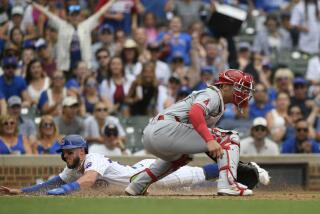Anderson High-Tails It Along Steppingstones : Pro baseball: Batting prowess hastens former Kennedy star’s ascent in Angel organization.
- Share via
Quick hands, fast feet, strong arm, power swing.
You do not fasten them to a belt or neatly tuck them in a carrying case, but in baseball they are the tools of the trade. If you have them you likely will wind up in a major league park.
Then there are exceptions such as Garret Anderson, left fielder for the Vancouver Canadians, the Angels’ minor league affiliate in the Pacific Coast League.
Anderson surely has big-league potential. Otherwise, he would not be the youngest player competing at the triple-A level.
Yet, in 65 games and 239 at-bats, Anderson has only two home runs and two stolen bases. He is, according to Vancouver Manager Max Oliveras, not much of a wiz on defense, either.
All of which leads to a rather obvious question: What exactly does this guy do?
There is a one-word answer: hit.
“He has a great line-drive swing,” said Jeff Parker, assistant director of minor league operations for the Angels, “a swing you’d kill for.” And one that usually results in solid contact.
Follow Anderson’s hit parade: From Kennedy High to Mesa, Ariz., and Boise, Ida., in 1990, to Quad Cities, Iowa, in 1991, to Palm Springs and Midland, Tex., last season and now to Vancouver, his has been a meteoric rise.
Or, in this particular organization’s case, make that an Angelic ascent.
After batting .323 in 81 games for Class-A Palm Springs, Anderson was promoted late last season to double-A Midland, where he batted .274 in 39 games. He made the leap to triple-A this spring.
Anderson, a fourth-round draft choice in 1990, has been a teen-ager most of his professional career. Today, on his 21st birthday, he is batting .301.
“Sometimes, with a young player like him, you worry about taking them up too fast,” Parker said. “(But) He has proven he can handle it.”
Not without trials and tribulations, though.
Anderson batted barely better than .200 the first month of this season. Oliveras recalls seeing a tearful Anderson being comforted by older players after a game in which he struck out with the bases loaded.
“He had to learn to deal with failure,” Oliveras said. “I told him, ‘You’re way ahead of schedule. Most guys, 20, 21 years old, they’re still in A-ball. These triple-A pitchers, they are smart.’ ”
Oliveras provided on-the-job training, keeping Anderson in the lineup even when he was slumping. The manager’s patience has paid big dividends.
Over a nine-game stretch in the middle of this month, Anderson raised his average 45 points by batting .529 with seven multiple-hit games.
“Playing every day, them giving me the opportunity to keep going back out there was the biggest thing,” Anderson said. “I needed a chance to make a couple of adjustments and they gave it to me. A lot of organizations might have sent me back down to double-A.”
In choosing to stick with him, the club might have considered Anderson’s track record. He experienced a similar slow start at Palm Springs last season. However, by the time he was promoted to Midland his bat was hotter than the desert sand.
History has taught Anderson not to give pitchers too much credit when he struggles. The way he sees it, the problem usually is him.
“The game doesn’t change,” Anderson said. “I’m playing against older and more experienced guys, yes. But they still have to throw the ball over the plate. That was my adjustment, waiting for them to come to me.”
Whether his average continues to rise, Anderson won’t have to wait long to find out how seriously he figures into his major league club’s future. At the conclusion of this season, the Angels must either protect him on their 40-man roster, or risk losing him to another team in the minor league draft.
Oliveras said Anderson “just has to keep doing what he’s doing” to be included in the Angels’ plans.
“He needs a little work still, but we’re talking about a young kid,” Oliveras said. “He has a bright future.”
Anderson weighs 205 pounds and is still growing into his 6-foot-3 frame. “I don’t think he will ever be a base stealer because he takes three or four steps to get going, but I can see him potentially being a 15 to 20 home run guy in the majors. His power is still developing,” Oliveras said.
Despite his modest home run total, Anderson has proved he can drive the ball for extra-base hits. He leads the Canadians with 19 doubles.
“None of the instructors has ever told me I needed to hit home runs,” Anderson said. “They feel it will eventually come.”
So, too, did Manny Alvarado, Anderson’s high school coach.
Kennedy High did not have a barrier in right field the left-handed hitting Anderson’s senior season. Alvarado had a temporary fence installed to take advantage of Anderson’s longball capabilities.
Otherwise, the coach correctly figured, opponents would simply retreat until they could play Anderson’s long drives on a few hops.
With the fence keeping right fielders honest, Anderson finished his senior campaign as the leader among City Section Valley-region players with eight homers and 36 runs batted in.
But in some circles there was a split on whether baseball was even his best sport. In basketball, Anderson averaged 23.1 points a game.
“I thought I was equal in both sports, but in basketball I didn’t have the opportunity to go on and play,” Anderson said.
Fresno State offered Anderson a scholarship to play baseball, but Anderson signed with the Angels only a week after the draft.
“I thought, ‘If playing baseball is what I want to do, why waste time?’ ” Anderson said.
That approach has become his modus operandi.
More to Read
Go beyond the scoreboard
Get the latest on L.A.'s teams in the daily Sports Report newsletter.
You may occasionally receive promotional content from the Los Angeles Times.







